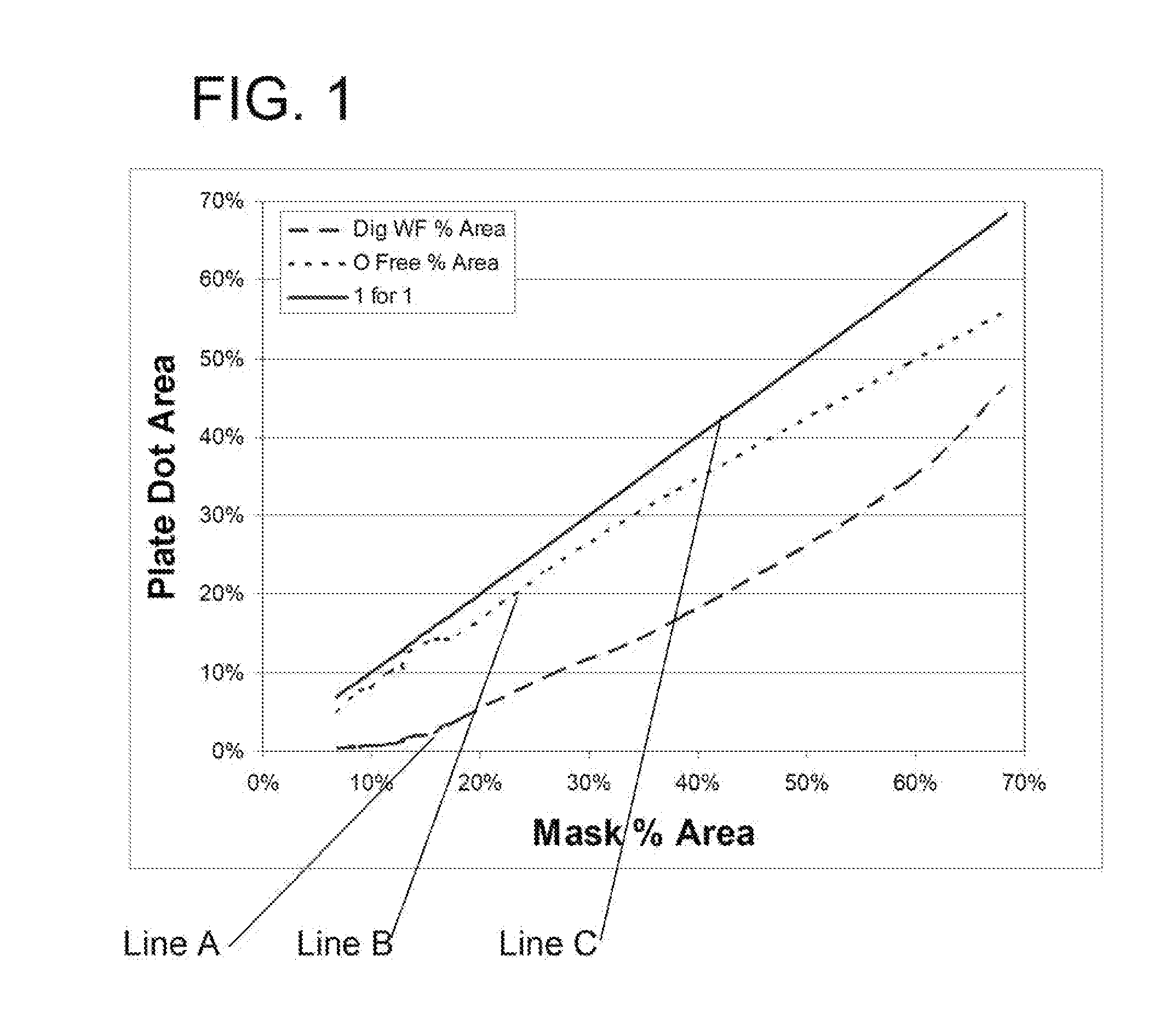Method for printing a material onto a substrate
- Summary
- Abstract
- Description
- Claims
- Application Information
AI Technical Summary
Benefits of technology
Problems solved by technology
Method used
Image
Examples
example 1
[0096]Two photosensitive precursor printing elements, CYREL® photopolymerizable printing plates, type DPI (0.067 inch (0.17 cm) thickness of photopolymer and support), having a ultraviolet radiation opaque layer disposed thereon, were identically imaged by ablating the radiation opaque layer with infrared laser radiation to create an in-situ mask on the element having a range of openings (1%, 5%, 10%, 20%, 50%, 70%, 90% area opening in mask) on a CYREL® Digital Imager. Opening size was measured on one plate with a Nikon measuring microscope to estimate the actual mask opening size. The line screen resolution was 150 lines per inch. Although outside of the recited range for high-resolution printing or coating by the present method, this example demonstrated the capability of the present method (of a modified digital workflow) to create feature sizes of raised surface elements in a relief structure of a relief printing form that are only slightly smaller than the corresponding opening...
example 2
[0101]This example demonstrates a comparison of three different plate fabrication methods 1) conventional analog plate fabrication which used a film intermediate 2) conventional digital plate fabrication (digital workflow) which formed an in-situ mask and imagewise exposed through the mask in the presence of atmospheric oxygen as detailed above, and 3) a modified digital work flow plate fabrication method, which formed an in-situ mask and imagewise exposed through the mask in the presence of an inert gas, e.g., nitrogen, and with a concentration of oxygen between 190,000 and 100 ppm, as detailed above.
[0102]CYREL® photopolymerizable printing plates were used as the photosensitive precursor printing elements, which differed by the presence or absence of a radiation opaque digital layer disposed on the element, but having the same or substantially the same photopolymerizable composition forming the elastomeric layer. CYREL® photopolymerizable printing plates, type DPU (0.067 inch (0.1...
example 3
[0110]A CYREL® photopolymerizable printing element having a radiation opaque digital layer, type DPI (0.045 inch (0.114 cm) thickness of photopolymer layer and support) was used to evaluate the ability to create very small structures of the raised surface elements when prepared according to the inventive method of the modified digital workflow. The digital layer was imaged by ablation to form an in-situ mask on a CYREL® Digital Imager. The element was imaged to form the in-situ mask having multiple image patterns at resolutions of 10,000, 8,000 and 4,000 scan lines per inch and at spatial resolutions of 300, 400 and 600 DPI (dots per inch). The element was placed in an exposure chamber as described in Example 1, and imagewise exposed to actinic radiation in the presence of nitrogen as the inert gas and with a concentration of oxygen less than 1000 ppm and above 100 ppm. The exposed element was solvent processed using conventional solvent processing conditions, to form a printing pla...
PUM
| Property | Measurement | Unit |
|---|---|---|
| Fraction | aaaaa | aaaaa |
| Fraction | aaaaa | aaaaa |
| Fraction | aaaaa | aaaaa |
Abstract
Description
Claims
Application Information
 Login to View More
Login to View More - R&D
- Intellectual Property
- Life Sciences
- Materials
- Tech Scout
- Unparalleled Data Quality
- Higher Quality Content
- 60% Fewer Hallucinations
Browse by: Latest US Patents, China's latest patents, Technical Efficacy Thesaurus, Application Domain, Technology Topic, Popular Technical Reports.
© 2025 PatSnap. All rights reserved.Legal|Privacy policy|Modern Slavery Act Transparency Statement|Sitemap|About US| Contact US: help@patsnap.com


